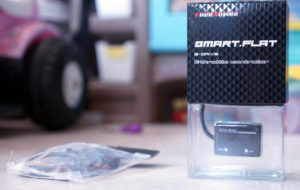 Throttle boosters have been around for decades, especially after the 80’s when electronic throttle control became more of a standard in modern cars. In layman’s term, throttle booster is a small digital device that intercepts and amplifies the electronic signal between the accelerator pedal and the ECU.
Throttle boosters have been around for decades, especially after the 80’s when electronic throttle control became more of a standard in modern cars. In layman’s term, throttle booster is a small digital device that intercepts and amplifies the electronic signal between the accelerator pedal and the ECU.
However, throttle control itself wasn’t always electronic. In the past, when you stepped on the gas pedal, the throttle plate immediately flips open and create a high speed vacuum to draw high volume of air into the engine compartment. The harder you pushed, the more power you’d get. It was simple and it was direct. Yet, it wasn’t very efficient because the vacuuming process put too much unnecessary load on the engine; thus wasting more fuel and affecting the longevity of many parts of the throttle system (if you want more details, check out this article by NYtimes).
Now in your Eos or other Volkswagen models, you certainly have an electronic throttle control.
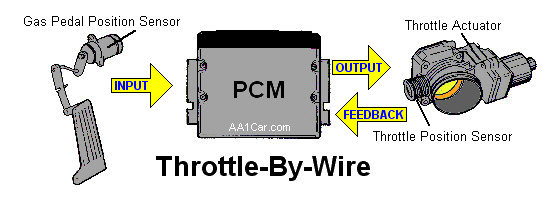
Image courtesy of aa1car.com
As opposed to the old way, once you step foot on the gas pedal, the request to open isn’t sent to the throttle valve right away. Instead, a sensor –called Pedal Travel Sensor, Part. 1K1 723 503 AK— measures your pedal position first and then it delivers this signal to the the central computer (a.k.a ECU or ECM/PCM); from here, the ECU combines inputs from other sensors such as the Mass Air Flow sensor, Boost Absolute Pressure sensor, etc…before it finally determines how much to order the throttle valve open via electric impulse.
Quite a complicated process there; and this system is called a drive-by-wire. A lot of people hate it, because it limits the power of the car; or the power is there somewhere, but it arrives very slowly to save on fuel, hence the hesitation. The benefit of this system is that now we have a smarter car; knowing when your wheels are slipping, reducing torque steering and helping the brake system work more effectively.
Over the years, the throttle booster is guilty as the cause of hundreds of debates in pretty much every forum about cars. People who have tried it, most likely will love it. Here are couple to read:
ft86club – Throttle Controllers, Myth or Magic? Sprint Booster Testing
golfmk6 – The drivability problem nobody is talking about: throttle response
On the other hand, people who haven’t due to the way they think how the device works, probably demand a trial by combat before they’d ever change their mind. You might also be told to get a stage 1 tune instead; but we’ll talk about that in a bit.
First, we understand that the throttle booster amplifies the signal to tell the ECU open the throttle more at a shorter time. People who opposes to the use of throttle booster would argue that you can get the same result by simply stepping the gas pedal harder; meaning a throttle booster is a waste of money. However, it’s only half of the equation. Take a look at the 3 scenarios below.
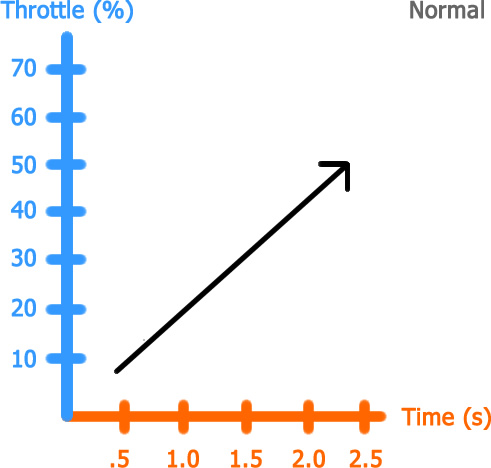 Scenario 1 – Normal foot pressure on the gas pedal gradually applied.
Scenario 1 – Normal foot pressure on the gas pedal gradually applied.
The graph is pretty lineage. Throttle open is completely determined by the ECU and pedal position; all the way until throttle fully opens at 100%.
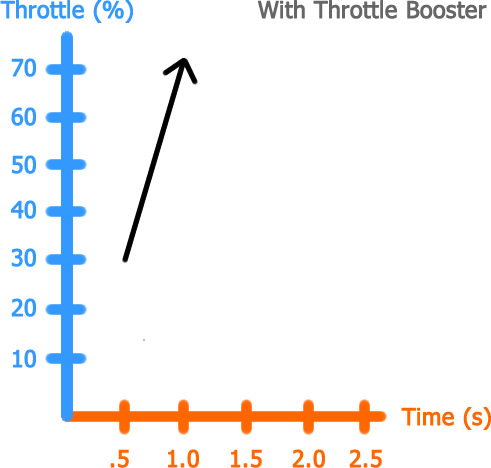 Scenario 2 – Normal foot pressure on the gas pedal gradually applied + Throttle Booster amplifies the signal 3 times.
Scenario 2 – Normal foot pressure on the gas pedal gradually applied + Throttle Booster amplifies the signal 3 times.
At 10% throttle will actually be seen at 30% by the ECU, 20% will be 60% , 30% will be at 90%, etc… until maxed out at 100%.
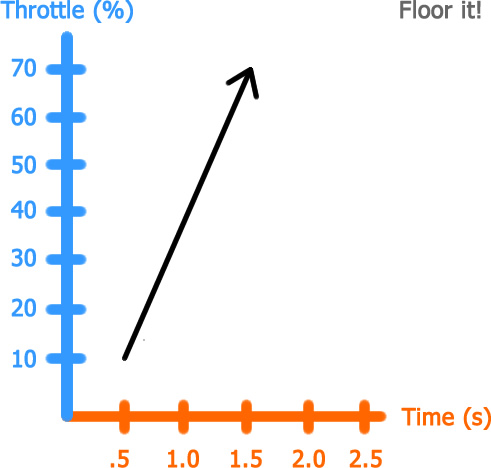 Scenario 3 – Stepping on the pedal HARD.
Scenario 3 – Stepping on the pedal HARD.
Due to the restriction of throttle position sensor, the throttle response is still being delayed; yet the amount of time it takes to 100% throttle open is much shorter than in normal acceleration.
As you can see, the electronic throttle control plays an important role in the acceleration of the vehicle. Perhaps, that multiplies ten fold when it comes to turbocharged engine, where turbo lag is also another problem. Though we have done several things in the past to improve the turbo lag, such as cleaning the MAF sensor, IAT sensor, MAP sensor, Dogbone insert, GFB DV+, Cold Air Intake, etc…though they have helped greatly, you could still feel the car quite dull and heavy –simply because the throttle control wants to save you gas plus the DSG transmission is known to be very indecisive at low gears.
- BOV DV gfb gofastbits Turbo
- Superb quality Turbo Acessories from HPTautosport
- Check description for further vehicle compatibility information
- Fast, reliable delivery
Most of us who drive other turbo engine or the 2.0T in our Eos definitely have experienced the 1-second hesitation, best described as where the engine seems to suddenly stall/loses power at low speed and jerks in low gears; then randomly wakes up and punches you to the seat; that makes even changing lane a risky attempt –you are either too slow, soon to be rear ended; or too fast you are gonna hit someone ahead. It’s a catch 22.
On other hand, those of use who drive in manual mode may see better response to your liking, yet at the end of the day you could still notice the laziness of such an aggressive engine.
So even if you are stepping that pedal all the way, you are still under close monitor of the throttle position sensor and this sensor only gradually increases the signal sent to the ECU. Normally, you always start at 10%~15% throttle open and then slowly raises up.
Under heavy foot, it will add 15-30% every half a second or less but it will never be as fast as having the signal amplified three, four or five times by a Throttle Booster.
Image on a coordinate plans, you got one graph looks a curve and the other one looks a stair –you bet one is smoother than the latter.
Plus many people feels very uncomfortable when pushing the gas pedal that hard in everyday traffic just to be able to change the lane. I have attempted it once, my wheels slipped and torque steer turned my car in every direction –it could be dangerous and unpredictable. It’s less of a problem with Torque Steering feature turned on, but it’s still a challenge when compared to a naturally aspirated engine in a Corolla or a Honda.
 Stage 1 tune technically recalibrates the engine’s and turbo charger’s efficiency –it deals with a very different part of the drivetrain. A tune tells the car to deliver power and torque at different conditions, so you could feel the car become more lively and experience less turbo lag. But turbo lag is not relevant to Throttle Response, especially Throttle Response Time.
Stage 1 tune technically recalibrates the engine’s and turbo charger’s efficiency –it deals with a very different part of the drivetrain. A tune tells the car to deliver power and torque at different conditions, so you could feel the car become more lively and experience less turbo lag. But turbo lag is not relevant to Throttle Response, especially Throttle Response Time.
Now the DSG Tune on other hand improves the gear management system. It helps your transmission shift more accurately and put down the power from Stage 1 tune more precisely.
Both tunes are considerably the best mods for the 2.0T engine, they will completely change the characteristic of your car. However, the drawbacks are that they are very expensive and put more stress on the engine. It will be at least $1100 before labor fees and if the Volkswagen finds out, your car will be tagged as TD1 thus voiding all powertrain related warranty, does not matter if the dealer is mod-friendly or not.
The Throttle Booster on other hand is between $150 to $300 and if you have read through the thread on mk6 forum at the beginning of this post, you’ll learn that a lot of people who had already tuned their car said that the Throttle Booster is even a better mod for the money than the Stage 1 tune itself. Some even go as far as giving a statement that if they have to do it all over again, they would have bought the throttle controller first before purchasing a Stage 1 tune.
And last of all, it does not void your warranty. But make sure to take it off before you run the car in for service.
4. Throttle Booster Options
There are several throttle boosters on the market that are compatible with the Eos 2.0 turbo and VR6 engines; though you may find it slightly less effective for naturally aspirated engine.
I do not have the VR6 engine to perform tests, but from the experience of the VR6 community in the first thread of the two links above, many owners definitely enjoy having the Throttle Booster in their car. Also in the same thread, a poster introduces Sprint Booster so that’s your first alternative option. Here are couple more choices:
- Boost your horsepower, torque, throttle response and fuel economy with the advanced...
- Easily installs in less than 15 minutes, with absolutely no mechanical experience...
- Makes NO permanent changes to your vehicle's computer! It will not void your factory...
- We strived to create the most high quality product in every aspect, delivering you the...
- FASTER ACCELERATION: The Pedal Commander system eliminates the delay from your electronic...
- 36 ADJUSTABLE SETTINGS: Equipped with 4 different modes: Eco, City, Sport, and Sport +....
- GAS SAVINGS: The Pedal Commander’s significantly slow Eco Mode response can help...
- QUICK & EASY INSTALLATION: Pedal Commander is a simple plug-and-play device that takes...
The reason I picked the SP11 is because I had my doubt just like anyone else who never used the throttle booster before. The SP11 humbly stood out from my research as a product that has been experienced by the Volkswagen community over the years, it has great feedback and it isn’t $300. For half that price tag, if the SP11 works out great that means I have struck gold. If not, it wouldn’t hurt too much.
So I pulled the trigger and placed the order with seller mtektuning88 (Taiwan) on Ebay. Nice guy, responded to everything I asked. And to my surprise, the package arrived at my door just two days later — by DHL, of all carriers! UPS would take two weeks just to lose my package.
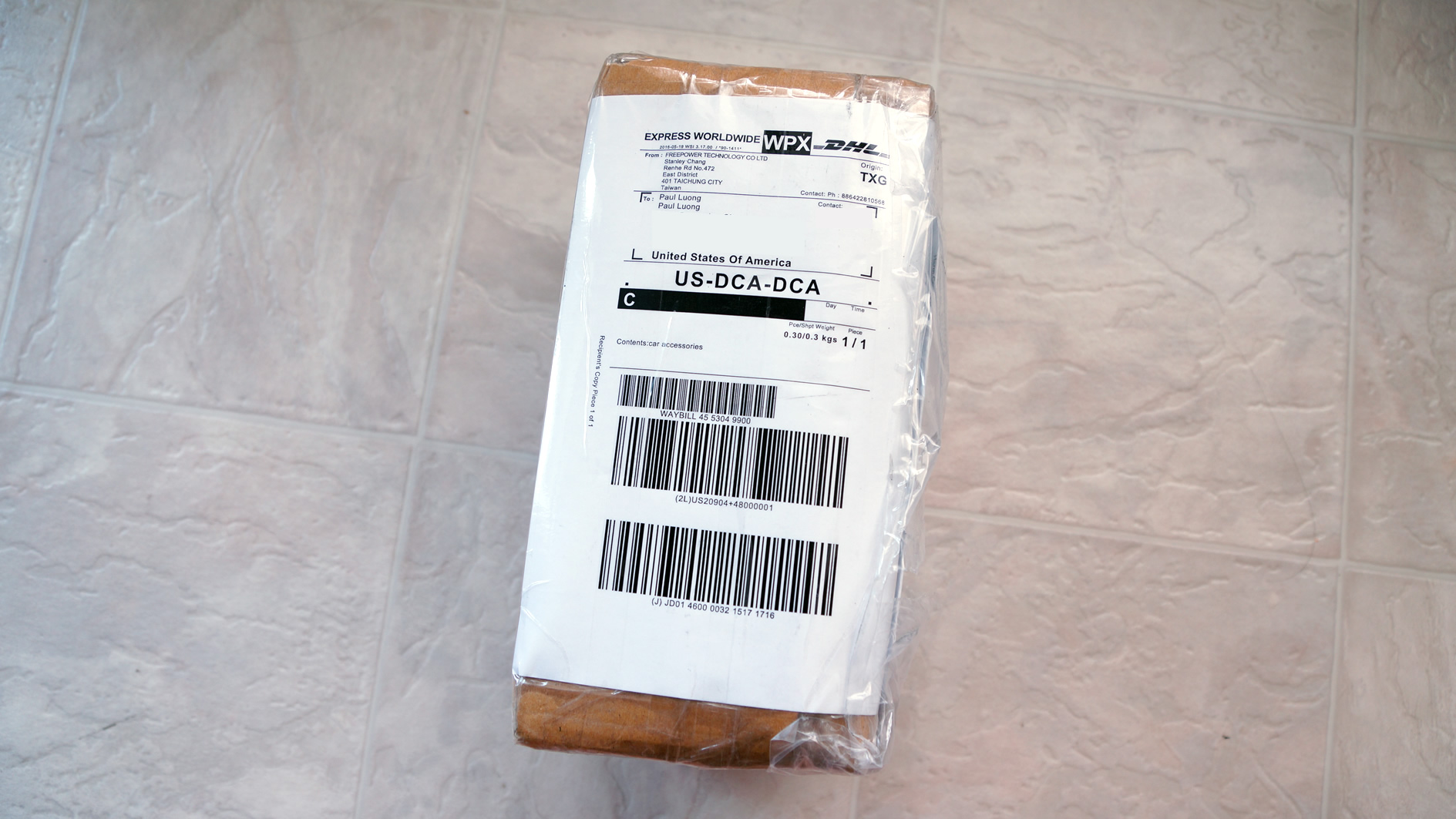
In the picture below, the bag on the left to the SP11 box — marked A9A — is the specific pedal connector for our VW Eos TSI model. There is a list of different connectors for different cars on the SP-11 page, make sure to take a look and confirm your vehicle’s fitment when order with your seller.
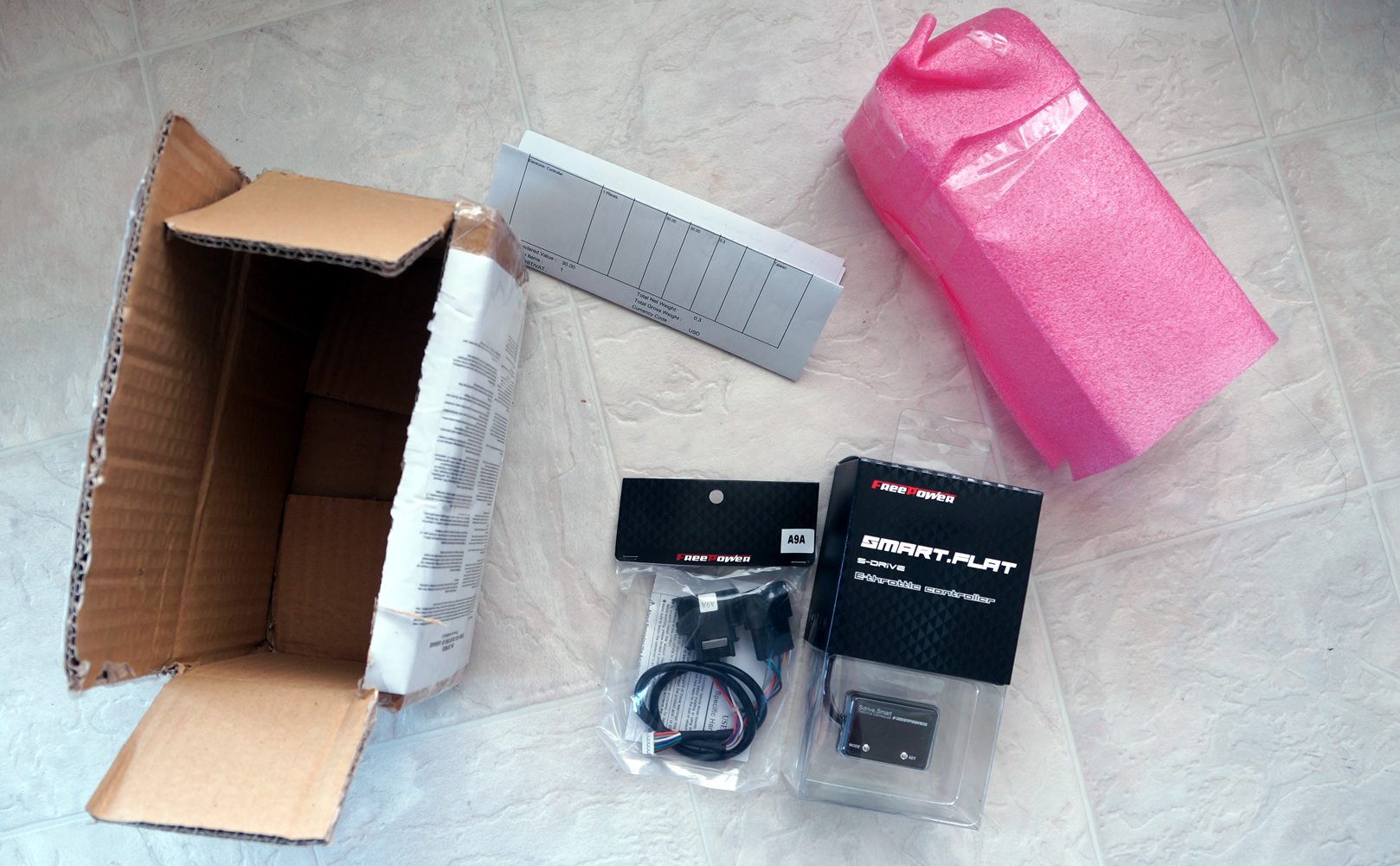
Here are what you should have inside the box. The content might be slightly different if you bought the newer Gen SDrive PRO+.
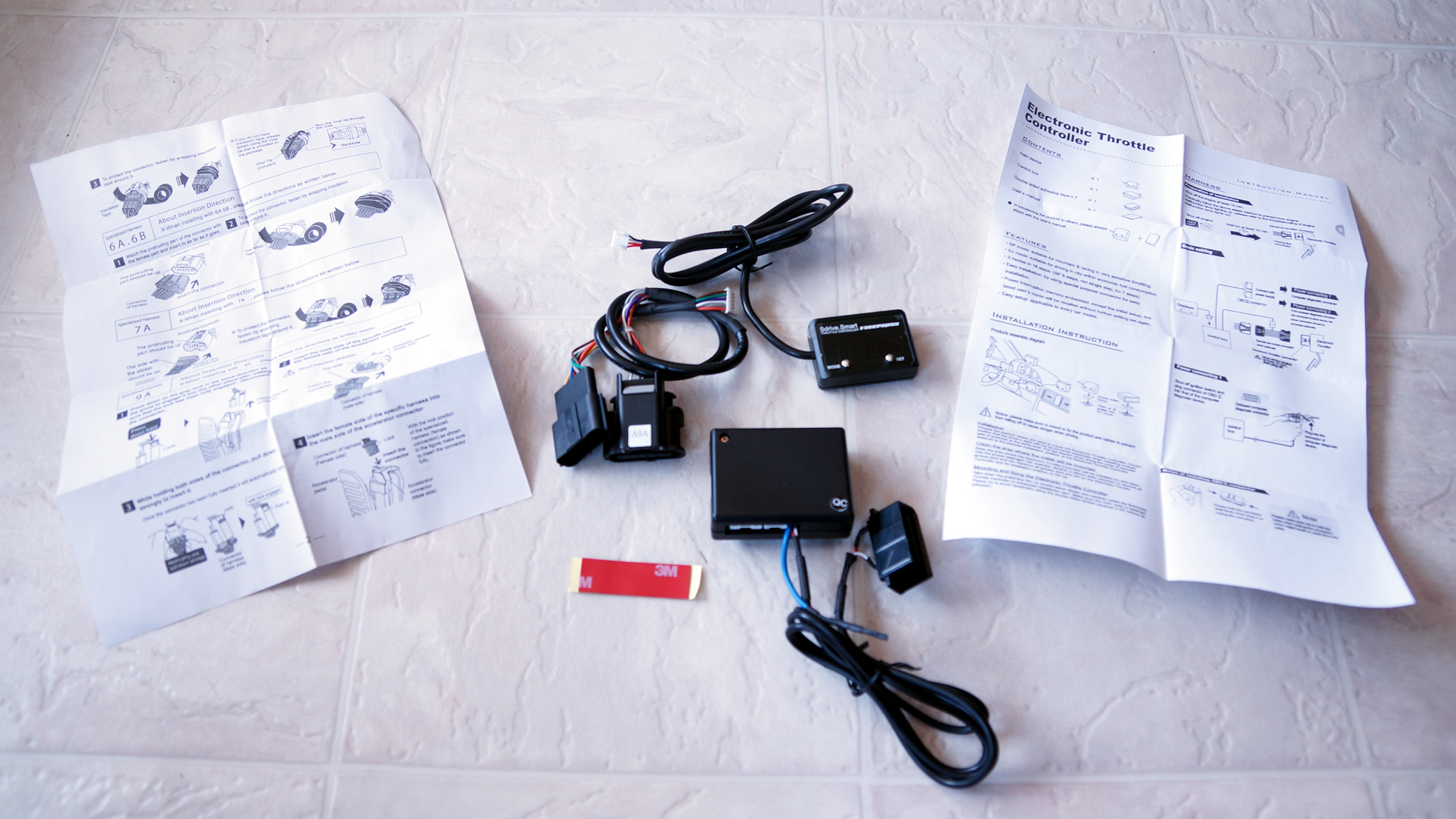
Simply plug 2 small white connectors of the display box and the pedal cables into the central processing unit and your device is ready to be installed in the car.
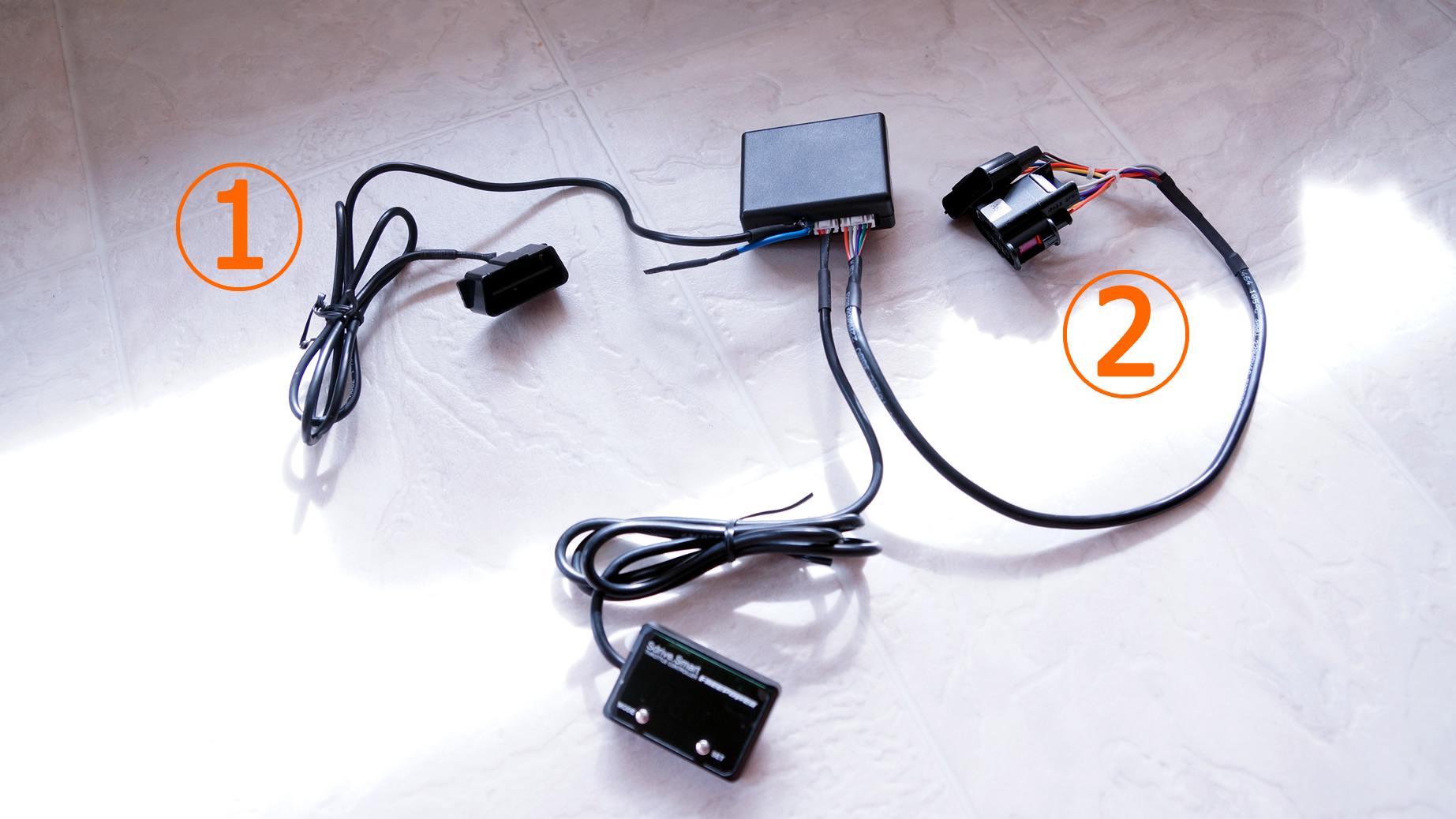
The ① is the power cable, which will plug into your OBD II port; while ② is to be installed between the gas pedal and the ECU. Now go ahead and remove the two screws that keep the bottom dust cover in place (behind your pedals).
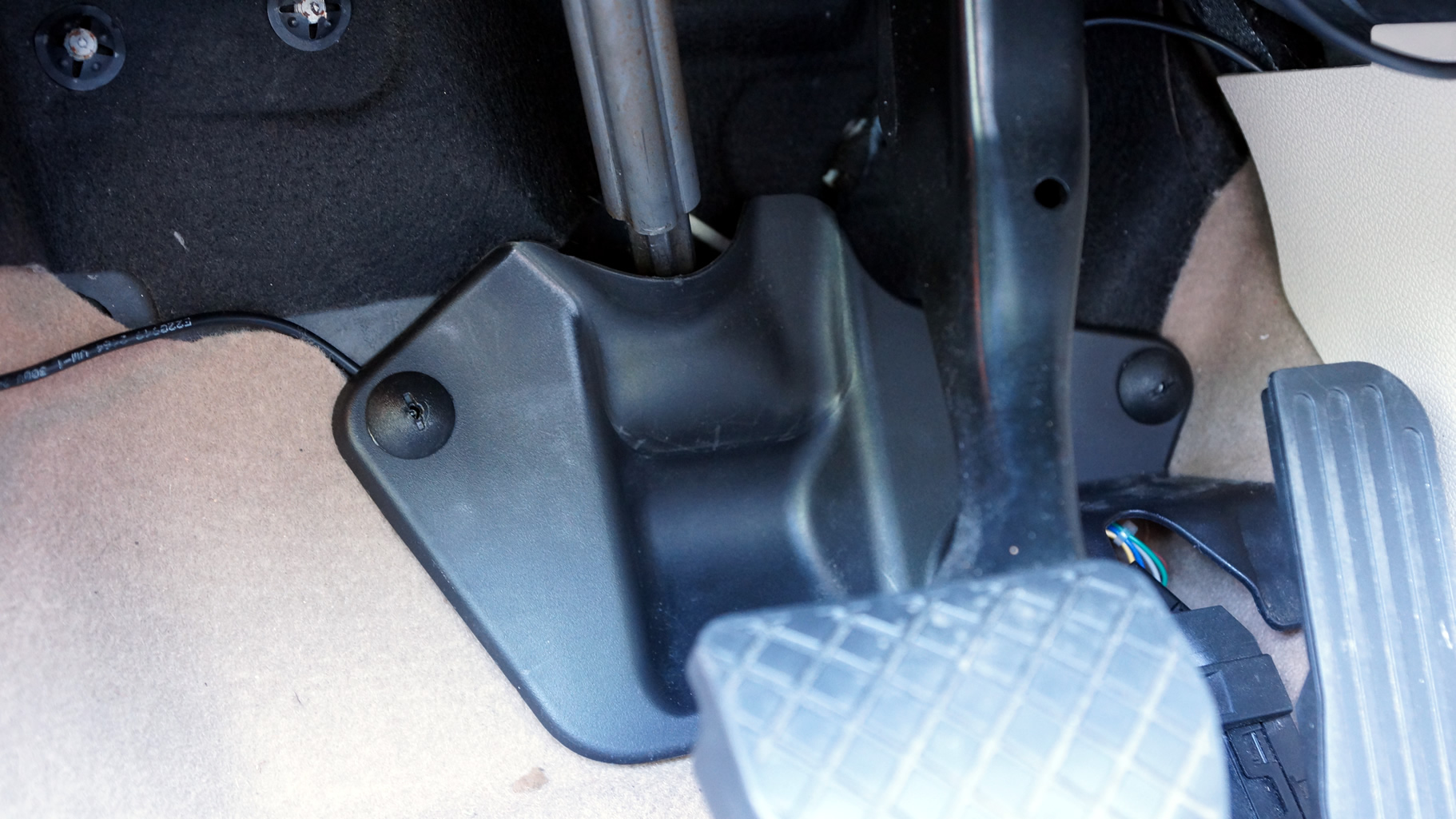
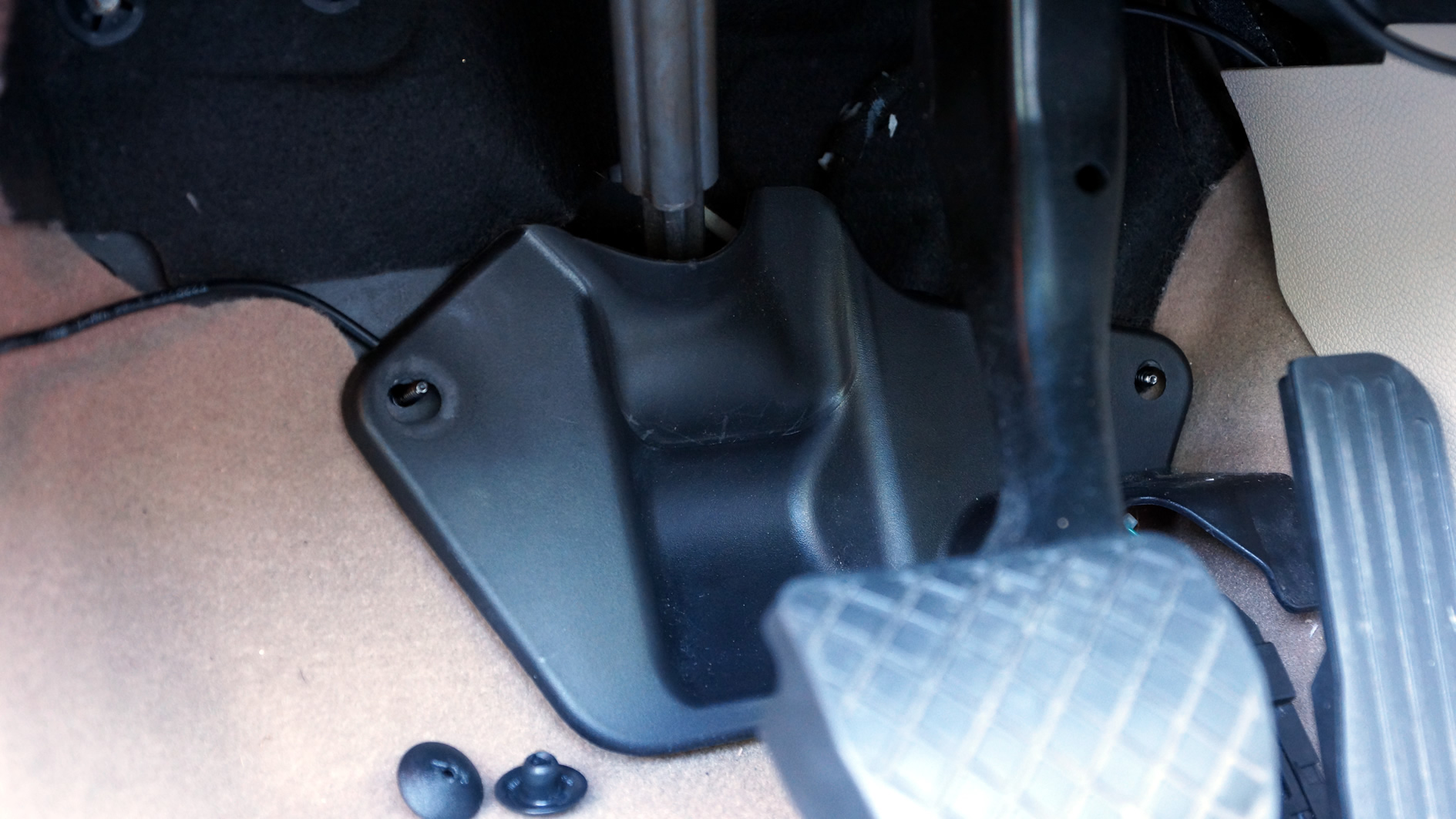
Now, plug ① into the car’s OBD II port undernearth the headlight switch.
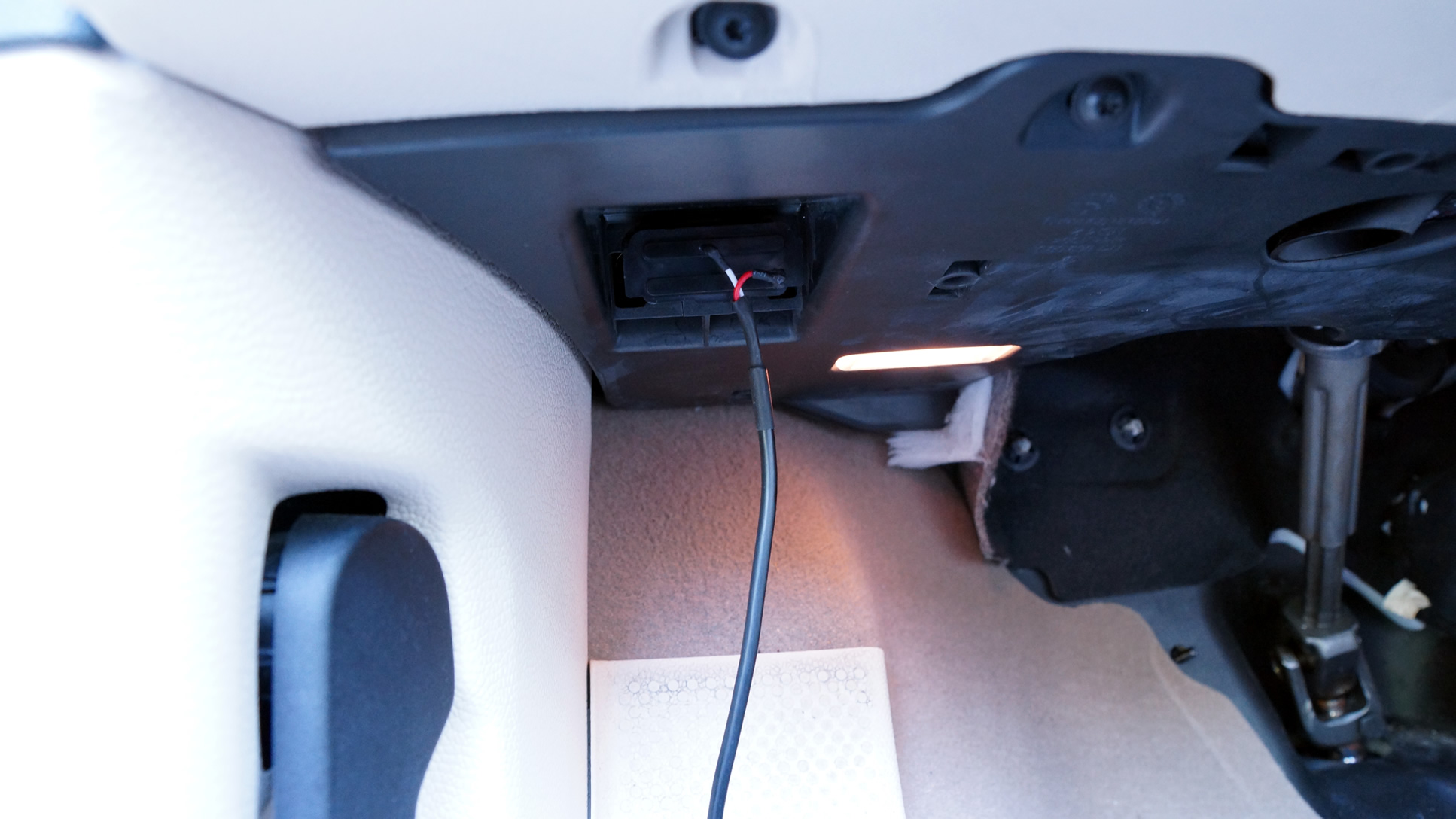
Turn off the car. Gently pull up the connector behind the gas pedal, then install ② as the bridge in between. One goes into the gas pedal connector, the other goes into the cable that was previously plugged into the gas pedal.
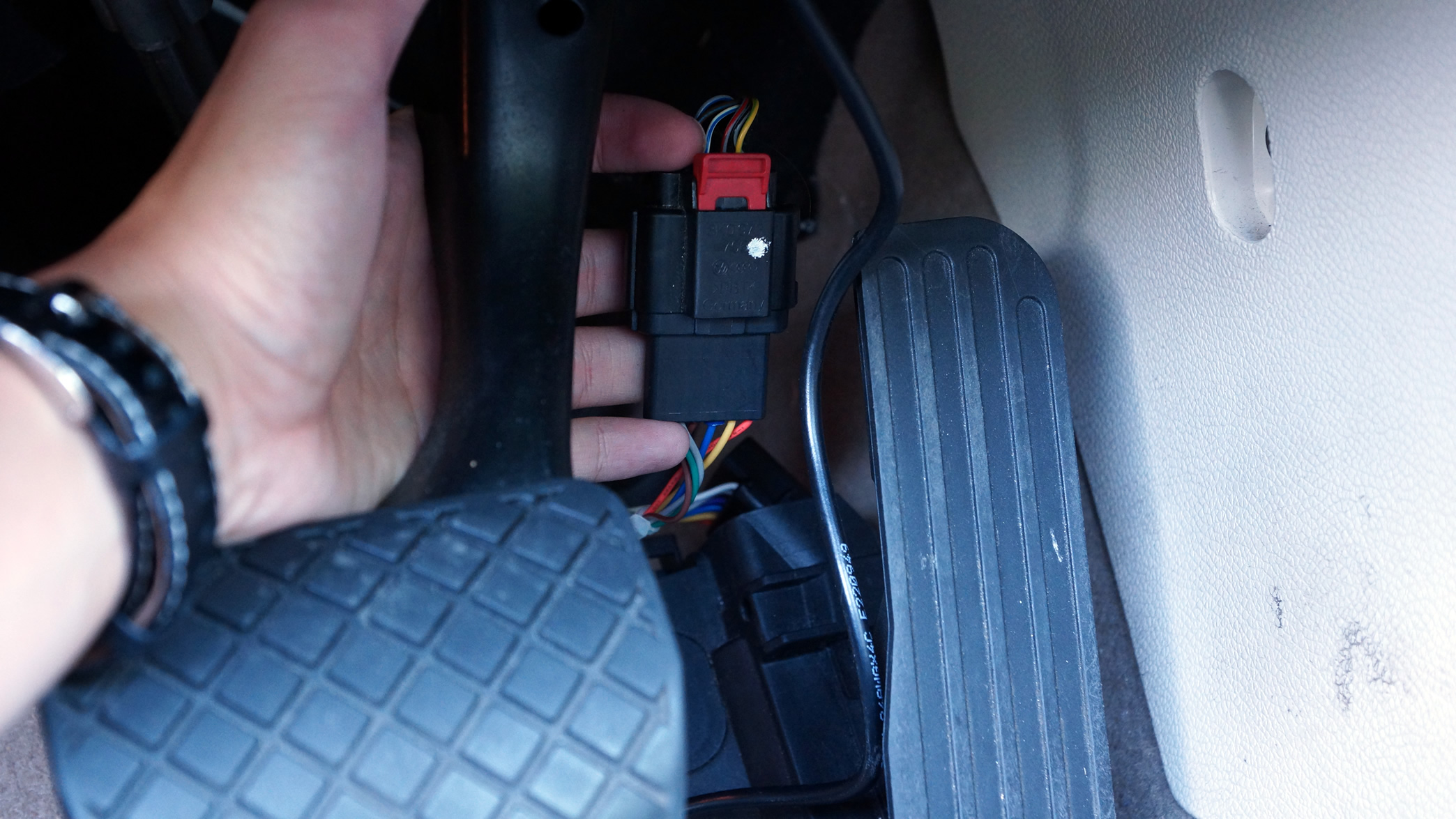
Once done, double check for all connectors. Make sure they are tight fit. I made a mistake of not plugging the power connector all the way into the ODB II port, and the device didn’t power up. Almost rage quit.
Reinstall the dust cover.
DO NOT START THE ENGINE. Instead, turn your key to ON position so you can initialize the SP11. Follow the manual page that came in the box and play with the settings on an empty back road to see which one you like best. I usually leave mine at SP4 or SP5. I did SP9-11 level in the video below and I spun my wheels like a burnout just on the lightest touch of the foot. The middle is a good balance between responsive and not killing yourself.
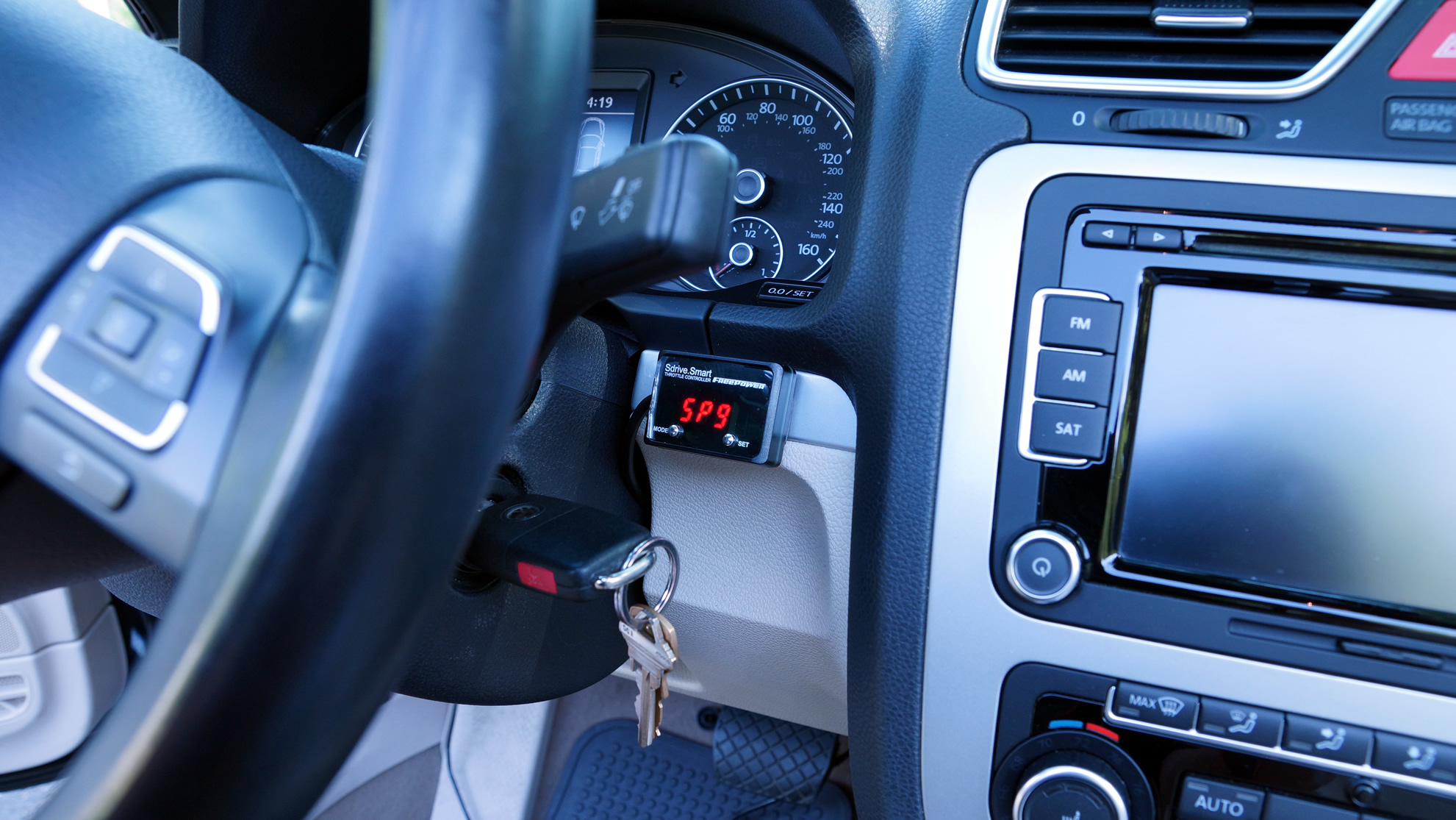
Our car is actually equipped with two different pedal sensors and I was curious to find out what would happen if the SP11 becomes malfunctioned or when it loses of power. So as something goes haywire with the device, the car will fall right into Limp Mode with both Check Engine Light and EPC Warning light on. Throttle pedal was deactivated and the car no longer accelerating, which removed my fear of an uncontrollable mad car doing 149mph on the street. I may actually do that one day with this song, though. You know, to save the world from the Darkness, Crowley, Leviathan and whatnot.
I had a chance to record some footage of the differences between having the SP11 in action vs. normal mode (stock). I’d like you to listen to the sound and notice how fast the power comes during each run, while my foot remains at a steady pressure.
 Drop us a comment to let everyone knows if this has helped your car. If you are an Eos owner, be sure to join our Facebook group for community help and more DIY articles in the future.
Drop us a comment to let everyone knows if this has helped your car. If you are an Eos owner, be sure to join our Facebook group for community help and more DIY articles in the future.
What’s Next ?
![]() DIY Cleaning Mass Air Flow sensor on your Volkswagen Eos to Restore Lost Power
DIY Cleaning Mass Air Flow sensor on your Volkswagen Eos to Restore Lost Power
![]() Installing Pendulum Dogbone and Rubber Mount Insert for Volkswagen EOS / TSI 2.0T
Installing Pendulum Dogbone and Rubber Mount Insert for Volkswagen EOS / TSI 2.0T



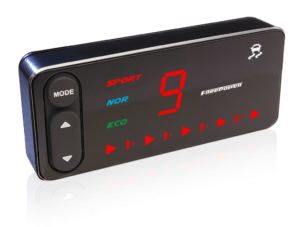
This is throttle control to reduce turbo lag w/o CAI? Can I still run a RaceChip piggyback tuner?
Thanks for the article.
Stock pedal position as reported to the car can go from 0-100 in under 100ms, yet the throttle body takes 1,000ms to open fully.
Amplifying it will only simulate stepping on the pedal further. Even if you can get the value up in less than 100ms, the car still takes 1,000ms to respond to that value. Prove me wrong with a graph of the 2 values with 100ms resolution, with and without this device.
Keyword is “reported”. The stock ECU is programmed to open the throttle gently, which is something you didn’t account for. In reality, it could take 2-3s for it to fully open. Anyone who owns a stock EOS or MK6 knows this acceleration hesitation. Prove yourself wrong by installing one and try it out yourself. Graphs and charts are just words for your knowledge. I can tell you the experience, but I can’t create one for you.
This may seem like a strange question, but I’ve got to try:
I’m not all that concerned with my throttle body responding faster when I put my foot down, rather I’d like it to snap shut faster when I chop the throttle to shift my manual gearbox?
Stock, my 2012 VW GLI had horrible “rev-hang” from most any RPM > 2,500.
The APR stage one tune resolve much of this at mid RPM range (<,4000 RPM) but above 5 or 6,000, it still “floats down” in its own sweet time to about 3,500, before dropping “normally.” In addition to the APR tune, I had a 16 lb. (vs 22 lbs. OEM) flywheel and HD clutch installed to reduce the angular momentum, which some “experts” insisted was what was keeping my revs high. They turned out to be wrong; it the ECM’s control of throttle closing.
So what I want to know is, will any “throttle booster” device will ALSO close my throttle more immediately, while I understand it will make the throttle body more responsive to opening quickly?
VCDS/OBD11 has a throttle body alignment feature that you can run once in awhile to calibrate the throttle body. However I doubt it would make much of a difference. What you need is a custom ECU tuneup whereas the tuner can set parameters for the throttle body position per your preference.